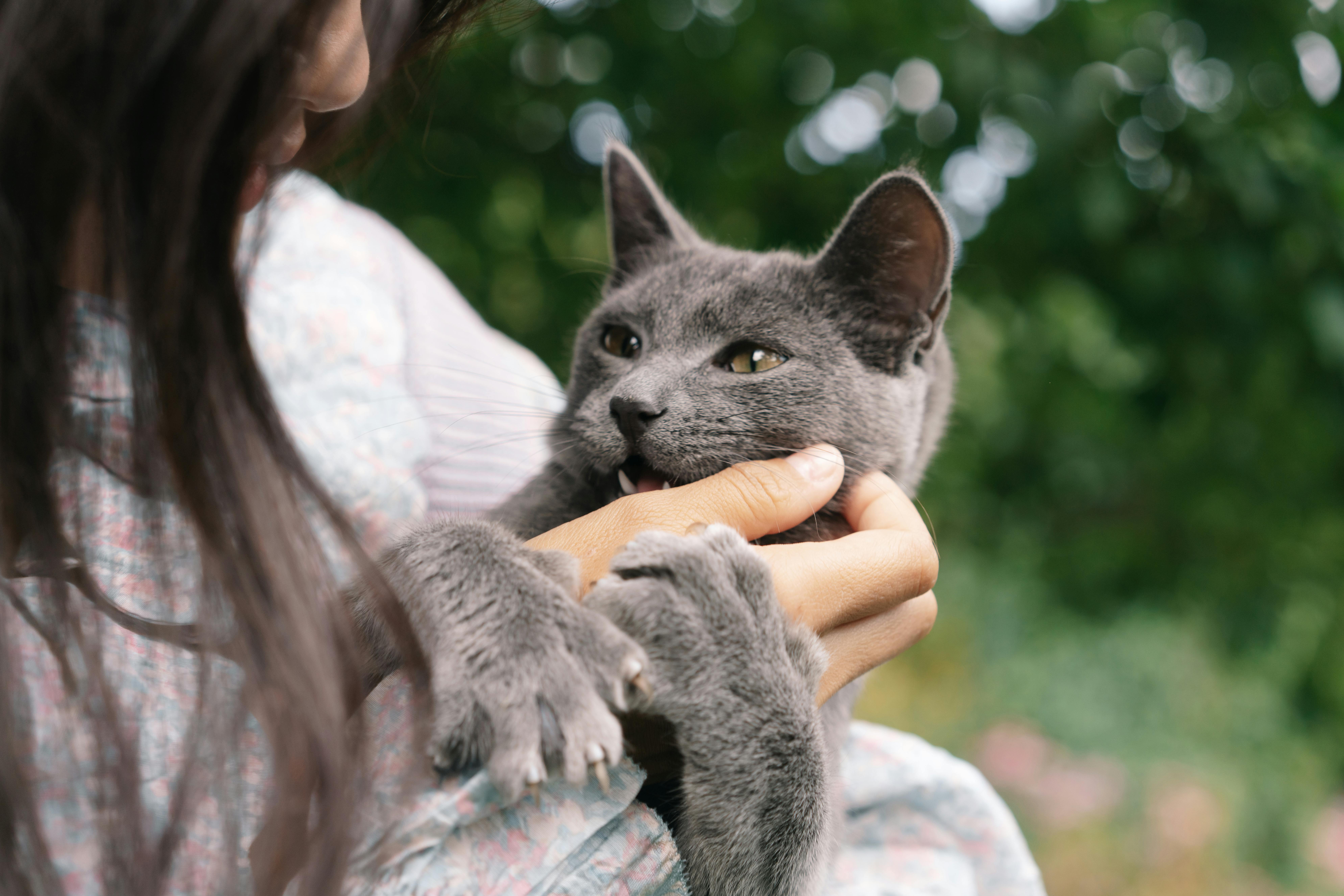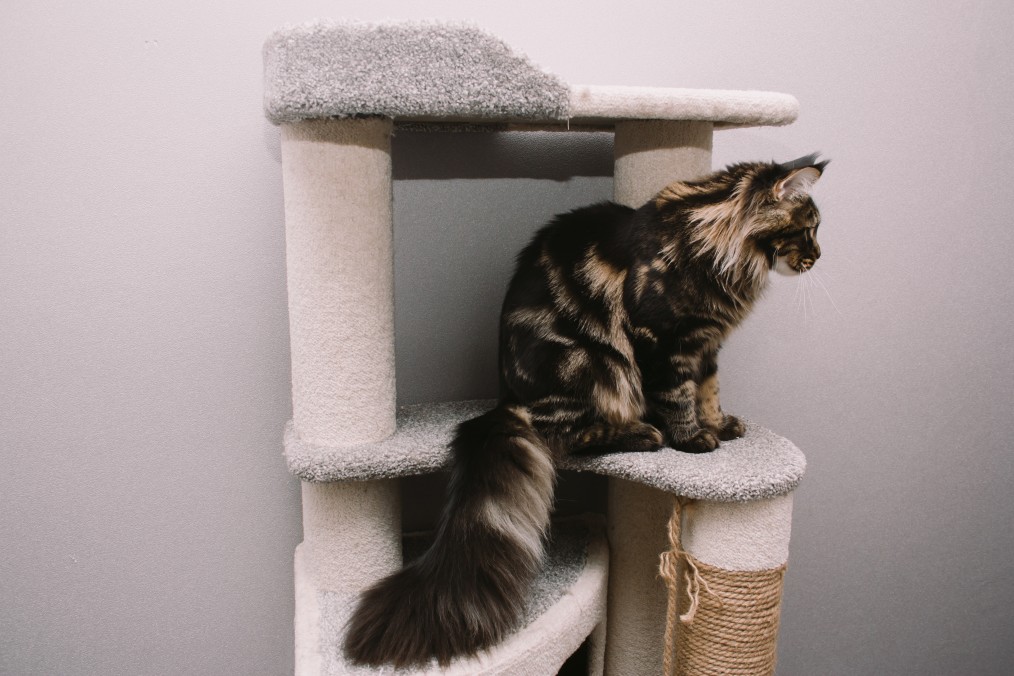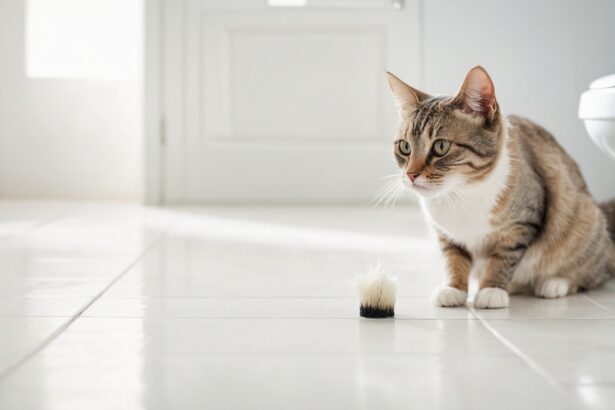Why cats bite: a language with teeth
Your cat’s mouth isn’t just for food — it’s also a way to speak. A gentle nibble, a quick snap, a bite followed by a lick… each has a message. The secret is reading the whole body: eyes, ears, whiskers, tail and posture.
Surprising fact? Tail movement isn’t “happy like a dog.” A twitching tip or fast swish can mean “I’m overstimulated — pause please.” If you’re curious about tail talk, explore the subtle meanings behind cat tail language.
Play bites, love bites, or overstimulation?
Play bites are common in kittens and energetic adults. They’re usually softer, often paired with pouncing, dilated pupils and a wiggly bum.
“Love bites” are quick, light nips during cuddles. They’re not malicious — more like “I adore you… but that was a lot of petting.”
Bites from overstimulation happen when petting passes a cat’s comfort threshold. Watch for early signs: tail-tip flicks, skin ripples, ears angling sideways, or a sudden stillness before the bite.
Fear, pain and redirected emotion
Some bites are defensive: if a cat feels cornered, startled or unsafe, they may bite to create distance. It’s not personal — it’s self-protection.
Pain can trigger biting too. A cat with dental trouble, arthritis or skin sensitivity may bite when a sore area is touched. New biting out of the blue deserves attention.
Redirected aggression is sneaky: your cat sees a rival outside, gets aroused and bites the closest thing — you or another pet. Learn the early signs of feline stress to defuse before it explodes.
How to react in the moment
First rule: stay calm and still. Yanking your hand away can trigger a chase-and-bite reflex. Freeze, then gently move your hand out of reach once your cat loosens up.
Redirect to a toy immediately. A kick toy, wand teaser or crinkly ball gives a “legal” outlet for all that energy.
End the session on a neutral note. Take a short break, then re-engage with a toy — not with hands.
The calm disengage-and-redirect method
- Freeze your hand for 2–3 seconds; avoid eye contact.
- Place a toy between you and your cat (kicker, wand, or soft mouse).
- Once the cat grabs the toy, withdraw your hand and praise softly.
- Resume play with distance toys (wand/throw toys) for 1–2 minutes to drain energy.
- Finish with a few treats scattered on the floor to switch the brain from “hunt” to “snack.”
Need more targeted help when your cat aims for your hand? Try these focused solutions for “cat bites your hand” moments.
Common mistakes to skip
- Using your hands as toys. It teaches that skin equals “bite me!” and becomes painful as cats grow.
- Punishing or yelling. Cats pair punishment with you, not the behavior. It erodes trust and can worsen biting.
- Rough play or wiggling feet under the blanket. You’ll awaken pounce mode — and your toes will pay for it.
Prevent biting before it starts
Cats need to hunt, catch, kill… and then eat — every day. That natural sequence is the antidote to bored, bitey behavior. Short, frequent play sessions beat one big burst.
Try a simple “3–2–1 Routine”: 3 mini wand-toy hunts, 2 puzzle-feeder moments, 1 calm cuddle (only if your cat asks for it). Predictable rhythm = fewer ambushes.
If your cat bites other cats during play or grooming, it can still be social learning or boundary-setting. Learn when neck nips are normal in multi-cat dynamics and when they’re not by reading why cats sometimes bite another cat’s neck.
Environment and enrichment
- Play: 2–4 short sessions daily with a wand toy; end each session with a small treat.
- Vertical space: cat trees and shelves to supervise their kingdom in peace.
- Scratching options: horizontal and vertical posts near nap spots and doorways.
- Foraging: scatter feeding or puzzle toys to occupy curious minds.
Want to protect your sofa while you teach good manners? Set up appealing scratch zones with these practical anti-scratch tips.
Gentle handling training
- Pet where your cat enjoys it most: cheeks, chin, base of ears; avoid long strokes down the back if they get twitchy.
- Keep sessions short; pause when the tail tip flicks or the skin ripples.
- Pair touch with micro-rewards: one treat every few seconds keeps arousal low and vibes sweet.
Kitten note: teach bite inhibition early. Say a soft “ow,” freeze, then switch to a toy. Consistency now prevents adult chompers later.
When to call the vet
Any sudden biting, especially when touched in one area, can signal pain. Think teeth, joints, skin, or tummy troubles. A check-up keeps everyone safer.
- Bites with weight loss, hiding, drooling, bad breath or head shaking.
- New sensitivity to brushing or being picked up.
- Escalating aggression despite calm training and enrichment.
Your vet can rule out medical triggers and may suggest behavior tweaks to support your cat’s comfort.
Little extras: tips, pitfalls and fun facts
One practical tip you’ll love
Create a tiny “bite-reset kit” in each room you cuddle in: a wand toy, a soft kicker and a handful of treats. If nips start, you’re ready to pivot — no frantic search required.
A common error to avoid (and why)
Don’t stare your cat down after a bite. In cat language, a hard stare can feel threatening and spike arousal. Instead, slow-blink or look to the side — it de-escalates the moment.
Fun, surprising nugget
Many cats have a “petting quota.” They enjoy short bursts, then need a break. That quick lick-after-bite? Often a peace offering: “We’re okay — I just needed space.”
FAQ
Why does my cat bite me gently when I pet her?
Those are often “love bites” or a signal that petting exceeded her threshold. Respect early warnings like tail-tip flicks and take a short cuddle break.
How do I stop my kitten from biting hands?
Freeze when bitten, then redirect to a toy. Reward calm play, never use hands as toys, and keep sessions short and frequent.
Why does my cat bite and then lick me?
It can be a mixed message: “I’m done” followed by a social reassurance lick. Pause petting, switch to a toy, or offer a treat scatter to reset the mood.
When is biting a sign of pain or illness?
New biting, especially when touching a specific spot, can mean discomfort. Dental pain, arthritis or skin issues are common — book a vet check to be safe.








